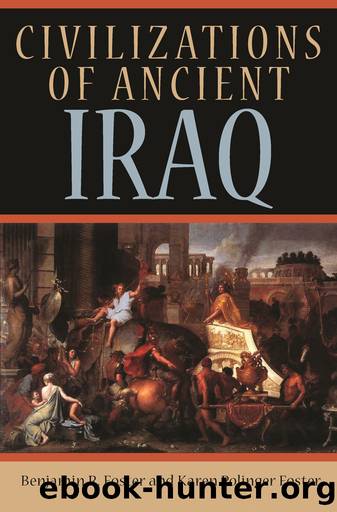Civilizations of Ancient Iraq by Benjamin R. Foster;Karen Polinger Foster;

Author:Benjamin R. Foster;Karen Polinger Foster;
Language: eng
Format: epub
Publisher: Princeton University Press
Published: 2021-10-15T00:00:00+00:00
The Rise of Parthia
The Seleucids and Alexanderâs other successors were not the only claimants to the territories of the old Persian Empire. In the steppes east of the Caspian Sea, where there is abundant seasonal pasturage for nomads, a new royal house arose in the third century B.C.E. This dynasty traced its origins to Arsaces, a charismatic Iranian leader, who in 238 B.C.E. seized control of the former Persian satrapy called Parthia. The nomadic peoples of Central Asia had no well-defined tradition of kingship. Instead, they recognized heads of families and a leader (khan) in time of war. The Parthians chose now to follow a Hellenistic model for kingship, later venerating Arsaces as a deified ruler somewhat akin to the way the deified Alexander was honored. And just as the Seleucid rulers numbered their regnal years from the beginning of the reign of Seleucus I Nikator, so the Parthian era reckoned continuously from the fixed date of the apotheosis of Arsaces.40
Even as they imitated the Seleucids, the early Parthian rulers expanded their realm at their expense, establishing a compact, powerful kingdom that essentially lay beyond the reach of Seleucid arms, despite temporary incursions. But the Parthians, in common with most rulers of the region from ancient to modern times, found greater Iran a challenging land to conquer and govern, in part because of the distinctive geography of the plateau, whose central area is largely desert. As a result, settled life tends to cluster in towns and cities rimming the edge, while nomads freely crisscross the rest of the country. The other nomadic peoples of the region proved difficult to subdue, unless surprised in their summer hillside pastures, where they had less mobility than in the winter, when they could move rapidly across flatter terrain to evade direct assault. We also see, time and again, that the steppes east of the Caspian and the pasturelands between the Syr Darya and Amu Darya rivers were the pressure points for peoples, such as the Scyths, forced west by developments as far east as China.
The Parthians eventually learned to manage their territory by seeking the allegiance of local chieftains and by building fortress cities at key locations. These cities were often circular for optimal defense, surrounded by massive walls that nomads lacking heavy siege equipment could scarcely hope to penetrate. Parthian military strategy was based on using elite units of archers on horseback, trained from boyhood in the equestrian arts and marksmanship. The Parthian bow, accurate to a distance of about 200 meters, with a drawing pressure of 30 kilograms, could readily pierce shields and armor. The archers were famous for the so-called Parthian shot, discharged at a gallop while pivoting backwards in the saddle, a feat requiring exceptional prowess, seen first in Assyrian hunting reliefs.41 The mounted troops were supported by tactical units of heavily armed infantry. Their combined attacks could only be met in kind, but neither the Seleucid phalanx nor the Roman legion could do so.
The strength of Parthia was also its weakness, a situation similar to what had plagued the Persian Empire.
Download
This site does not store any files on its server. We only index and link to content provided by other sites. Please contact the content providers to delete copyright contents if any and email us, we'll remove relevant links or contents immediately.
| Africa | Americas |
| Arctic & Antarctica | Asia |
| Australia & Oceania | Europe |
| Middle East | Russia |
| United States | World |
| Ancient Civilizations | Military |
| Historical Study & Educational Resources |
The Battle of Mogadishu by Matt Eversmann & Dan Schilling(610)
The Confidence Men by Margalit Fox(534)
The Spymaster of Baghdad by Margaret Coker(533)
A History of the Muslim World since 1260: The Making of a Global Community by Vernon O. Egger(516)
Jack the Ripper and the East End by Peter Ackroyd(472)
Empire of Fear: Inside the Islamic State by Andrew Hosken(464)
Islam At The Gates: How Christendom Defeated the Ottoman Turks by Diane Moczar(460)
The Crimean War by Winfried Baumgart(460)
The Afghanistan File by Prince Turki AlFaisal Al Saud(456)
The Jerusalem Diamond by Noah Gordon(454)
Akhenaten by Dominic Montserrat(442)
A Concise History of Greece (Cambridge Concise Histories) by Richard Clogg(441)
Israel: Ancient Kingdom or Late Invention? by Daniel I. Block(438)
The History of Jihad by Robert Spencer(430)
Enemy in the East by Rolf-Dieter Müller(428)
The Privatization of Israeli Security by Shir Hever(425)
Destroying a Nation: The Civil War in Syria by Nikolaos van Dam(423)
The Nine Lives of Pakistan by Declan WALSH(415)
The Dirty War in Kashmir by Shujaat Bukhari(404)
